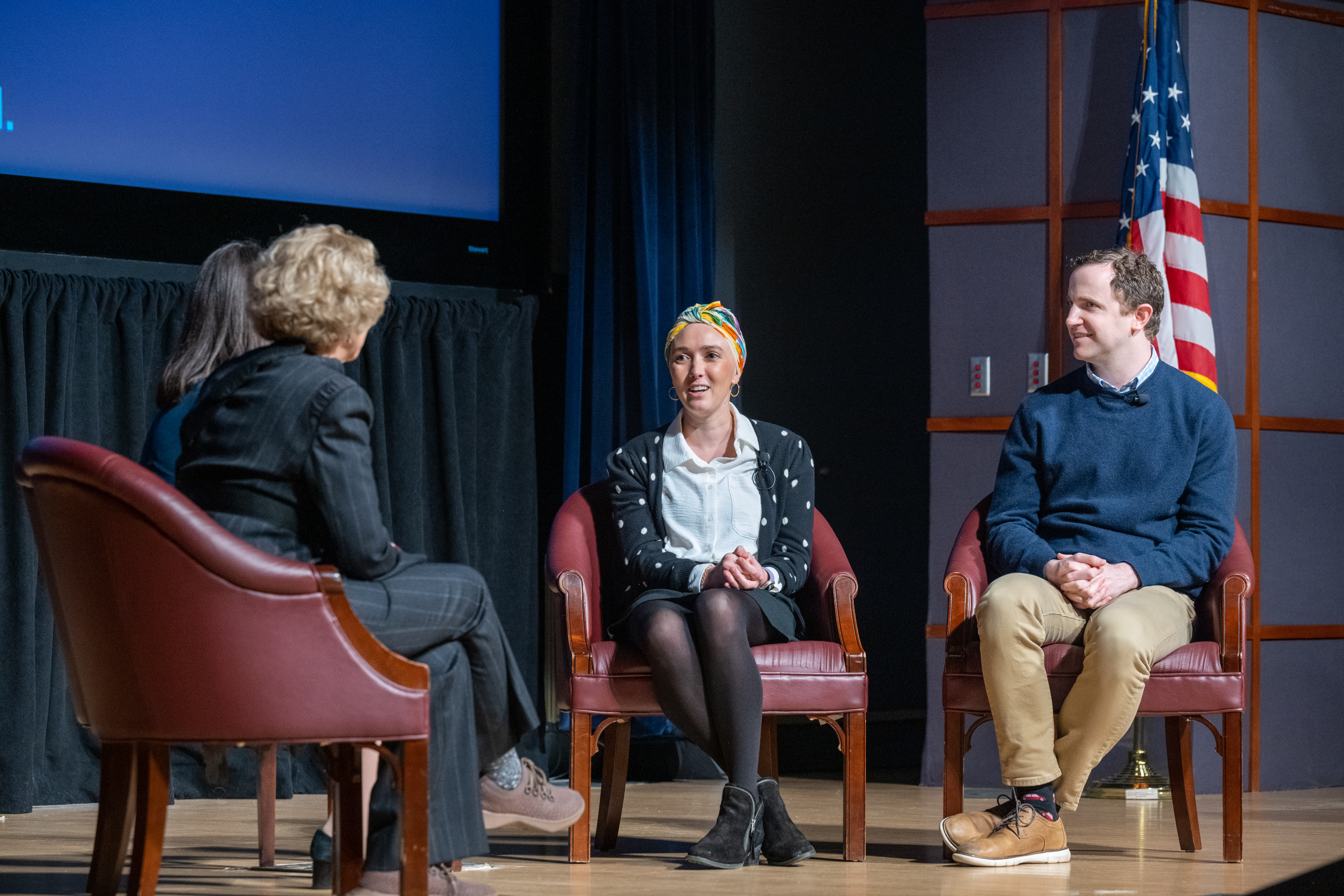What not to expect when expecting: when prenatal screening suggests cancer
NHGRI researchers find that specific abnormal chromosomal patterns in prenatal blood tests warrant whole-body MRI cancer screening.
In the fall of 2022, Erica felt like she was on top of the world. She had just gotten married in the summer, had a beautiful honeymoon and found out that she was pregnant. She and her husband, Jordan, were thrilled to start a family together soon.
At 10 weeks along in her pregnancy, she had a check-up appointment and took a blood test to screen for possible chromosomal abnormalities in the fetus.
“At that point, we were delighted, sharing the news with our friends and family,” says Erica. “We were celebrating this exciting thing that was about to happen to our lives.”
About a week later, the doctor called and said the tests showed a partial duplication in one of the chromosomes was detected, and that they should see a genetic counselor immediately.
The couple found it hard to sit still over the next few days, worrying about what the results meant for their future baby. But when they met with the genetic counselor, she said the genetic abnormality wasn’t likely to be from the fetus but from Erica. The genetic counselor explained that these results pointed towards a maternal malignancy — the presence of cancerous cells.
“When she said cancer, I was in complete denial,” said Erica. “I was in the best shape of my life, and I had no symptoms except early pregnancy symptoms. I couldn’t believe what she was telling me – it wasn’t adding up.”
Prenatal screening tests can detect tumor DNA shed in the bloodstream
Prenatal blood tests, known as non-invasive prenatal testing, entered the clinic in 2011, giving parents the option to screen for the presence of extra chromosomes, such as trisomy 21 (Down syndrome) in the fetus in early pregnancy. These tests detect freely floating DNA in the bloodstream, consisting of the pregnant person’s DNA along with placental DNA, which is genetically similar to fetal DNA. Since the tests are highly accurate and only involves a blood draw, they have quickly become routine in pregnancy screening.
Each year, around two million pregnant people in the U.S. undergo non-invasive prenatal testing, according to Diana Bianchi, M.D., director of the Eunice Kennedy Shriver National Institute of Child Health and Human Development (NICHD) and senior investigator at the National Human Genome Research Institute (NHGRI) Center for Precision Health Research. But a few years into the use of these tests, clinicians started to see unexpected results. For example, the blood test might indicate extra chromosomes in the fetus, but more invasive diagnostic follow-up tests — such as those that sample fluids surrounding the fetus or placental cells — might indicate a typical set of chromosomes in the fetus.
In some of these cases, the atypical results can be explained by benign tumors, autoimmune diseases, or blood abnormalities in the pregnant person. In rare cases, the pregnant person has cancer.
When a person has cancer, the tumor grows and sheds DNA into the bloodstream, which is then detected by the prenatal testing methods.
While there are guidelines for clinicians to order additional follow up tests to evaluate the fetus, there aren't any evidence-based guidelines to evaluate the pregnant person.
"We knew that there was an association between these abnormal test results and cancer, but there is a big gap in clinical practice about what to do when a test result comes back as ‘non-reportable,’ or inconclusive,” said Dr. Bianchi. “We wanted to understand the best approach to decide which pregnant people receiving these results need further testing for cancer. Our goal is to save lives.”
Dr. Bianchi and her research group started a clinical study at NHGRI called Incidental Detection of Maternal Neoplasia Through Non-invasive Cell-Free DNA Analysis (IDENTIFY), a study that Erica was referred to and eventually participated in. The study involves a series of follow-up medical tests, including a magnetic resonance imaging (MRI) scan of the whole body. The researchers also surveyed the participants to understand their experiences receiving the prenatal test results and how they made the decision to be screened for cancer during their pregnancy.

Caption: Erica and Jordan speak about their experiences with the IDENTIFY study at NHGRI's symposium in 2023. Credit: Chiachi Chang, NIH
Nearly half of the study participants with specific abnormal results had cancer
After Erica enrolled in the IDENTIFY study, she remained doubtful about what the results meant.
“We poured over the medical literature and thought about all sorts of possibilities — maybe it was a vanishing twin, placental mosaicism — just anything besides cancer,” she says. “Part of me thought that I should participate in this study to find out that it wasn’t cancer.”
On the morning of her MRI appointment, Erica came to the NIH Clinical Center and lay down in a narrow tube, completely still, as the large cylindrical machine whirred. She asked the technician to play an upbeat Taylor Swift playlist to calm her nerves. By the afternoon, she received news that she had a 3 ¼ inch mass in her chest. She would then have to get a biopsy for a diagnosis.
“I remember thinking, ‘You must have the wrong girl because I have no symptoms and I’m breathing fine,’” says Erica. “When I looked at the scan, I thought, ‘How is it possible that I don’t feel anything inside my chest?’”
The biopsy showed that she had non-Hodgkin's lymphoma, a type of cancer in the lymphatic system, part of the body’s immune system.
Since the IDENTIFY study started in 2019, Dr. Bianchi and her group have seen 107 participants with abnormal or inconclusive prenatal screening results that might indicate the presence of cancer. Nearly half of these participants indeed had cancer, and many of them, like Erica, had no symptoms or ascribed their symptoms to pregnancy. The researchers also found that a specific pattern of multiple extra and missing chromosomes or parts of chromosomes was highly suggestive for the presence of cancer in the pregnant person. The findings are reported in a recent paper, published in The New England Journal of Medicine.
“When we first started the IDENTIFY study, people thought we were on a fishing expedition,” said Amy Turriff, Sc.M., genetic counselor at NHGRI and first author of the paper. “Many people thought it would be unlikely to find cancer in young and healthy pregnant people, but our study challenged everyone’s expectation.”
The researchers found that whole-body MRI could detect these silent cancers 98% of the time and is an effective and safe diagnostic tool for pregnant people who receive prenatal screening results suggesting malignancy. Other lab tests that clinicians typically use to scan for cancer, such as physical examination, blood tests and fecal tests, did not seem to help diagnose cancer in these patients.
"We’ve seen participants whose cancer had spread to their liver, but their liver function tests would come back normal.” says Dr. Bianchi. “Clinical evaluations that were previously recommended in the medical literature were falsely reassuring. We found that whole-body MRI was the most helpful test to help us distinguish between pregnant individuals who have or didn’t have cancer, allowing us to recommend following up with a biopsy of the mass to determine the type of cancer.”

Caption: NHGRI Genetic Counselor Amy Turriff and Senior Investigator Dr. Diana Bianchi lead the IDENTIFY study to better understand prenatal DNA test results and how they can predict cancer, if present, during pregnancy. Credit: Ernesto de Aguila III, NHGRI.
Navigating pregnancy and cancer
For Erica and Jordan, figuring out a treatment plan was another difficult hurdle to overcome.
“Oncologists aren’t used to treating pregnant people, and obstetricians aren’t used to having patients with cancer,” says Turriff.
The couple visited multiple oncologists, all of whom had different ideas for treatment plans. They wrestled with deciding which one would be the safest for the fetus before finally deciding to move forward with one.
“I was so anxious that my chemotherapy would do something to the baby,” she said. “The first day of treatment was extremely emotional but I had the unwavering support of my family and community, including a tremendous team of doctors who stood by me every step of the way.”
Around one in 1,000 pregnant people are diagnosed with cancer. However, pregnant people are typically excluded from clinical trials for cancer treatment, so it can be difficult for patients to know how safe certain drugs are for fetuses.
Since most of the organs in the fetus are developed by the start of the second trimester,there is less risk of developing congenital disorders when chemotherapy is given in the second or third trimester. In these cases, it’s safer to treat the pregnant person with the baby in the womb rather than deliver a premature baby that won’t be exposed to chemotherapy, according to Dr. Bianchi.
Several months and numerous rounds of chemotherapy therapy later, Erica delivered a healthy, beautiful baby boy. Shortly afterwards, her follow up scan showed that she was in remission.
“We named him Teddy because it means ‘protector’,” says Erica. “He’s my protector.”
Catching malignancy earlier in pregnancy
To date, the IDENTIFY study has helped numerous participants get a diagnosis. Many of them had lymphoma and, in some cases, rare tumors. Often, the participants are in the early stages of cancer, but some had advanced cancer — usually without any signs or symptoms.
Of the study participants who were found to not have cancer, some had benign tumors in the uterus, known as fibroids; abnormal chromosomal patterns only in the placenta, known as placental mosaicism; or a precancerous condition that affects the blood stem cells, known as clonal hematopoiesis.
Dr. Bianchi and her group hope that the results of this study can change medical management of patients who receive abnormal or inconclusive prenatal blood test results that point towards cancer, ultimately helping clinicians make decisions about their care.
“By recognizing malignancy earlier when people aren’t experiencing symptoms, and the damage hasn’t been done by the tumor, we hope to minimize the effects of cancer and to help lengthen lives,” says Dr. Bianchi. “Patients may be able to have shorter chemotherapy cycles because of the earlier detection. Importantly, being pregnant is not a reason to delay treatment or medical management. These results need to be followed up as soon as possible.”
The research group also hopes that this study will provide evidence that a whole-body MRI is necessary to detect cancer in these individuals — and that this will help change medical guidelines such that insurance companies will be able to make diagnoses in these cases more affordable and accessible.
Looking ahead, the researchers hope to find more genetic biomarkers, or measurable substances, in the blood that may be indicative of cancer, which can help with diagnoses. Biomarkers that are easy to test for are particularly important for people living in more rural areas who may not have access to medical facilities with MRI machines.
While receiving these unexpected findings added stress to their pregnancies, many participants in the IDENTIFY study valued knowing the information and none of them expressed regret about pursuing genetic prenatal testing.
“I wish I never had to go through cancer but I’m thankful I was directed to the study as quickly as possible and the cancer was detected so early, otherwise my outcome would’ve been very different,” said Erica. “I encourage all women to go through the test and get informed from the start.”
NHGRI’s IDENTIFY study is still recruiting participants. Find out more information about the study.
Last updated: December 4, 2024
